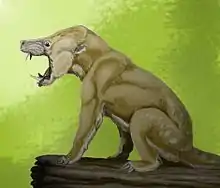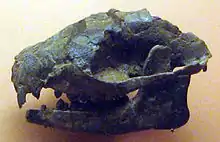
Condylarthra is an informal group – previously considered an order – of extinct placental mammals, known primarily from the Paleocene and Eocene epochs.[1] They are considered early, primitive ungulates. It is now largely considered to be a wastebasket taxon, having served as a dumping ground for classifying ungulates which had not been clearly established as part of either Perissodactyla or Artiodactyla, being composed thus of several unrelated lineages.[2][3][4]
Taxonomic history
Condylarthra always was a problematic group. When first described by Cope 1881, Phenacodontidae was the type and only family therein. Cope 1885, however, raised Condylarthra to an order and included a wide range of diverse placentals with generalized dentitions and postcranial skeletons. More recent researchers (i.e. post-WW2) have been more restrictive; either including only a limited number of taxa, or proposing that the term should be abandoned altogether.[5] Due to their primitive characteristics condylarths have been considered ancestral to several ungulate orders, including the living Artiodactyla, Cetacea, Perissodactyla, Hyracoidea, Sirenia, and Proboscidea, as well as the extinct Desmostylia, Embrithopoda, Litopterna, Notoungulata, and Astrapotheria.[6]
Prothero, Manning & Fischer 1988 delimited condylarths as those having the following characters, but lacking the specializations present in more derived orders:[5]
- superior ramus of stapedial artery shifted to petrosal or lost
- mastoid foramen lost
- bulla if present composed of ectotympanic
- relatively bunodont teeth with low cusp relief
- trigonids of lower molars shortened anteroposteriorly
- large, posteriorly projecting hypoconulid on M3 (lower third molar)
- head of astragalus is short and robust
Evolutionary history

The disappearance of the non-avian dinosaurs opened up an ecological niche for large mammalian herbivores. Some condylarths evolved to fill the niche, while others remained insectivorous. This may explain, in part, the tremendous evolutionary radiation of the condylarths that we can observe throughout the Paleocene, resulting in the different groups of ungulates (or "hoofed mammals") that form the dominant herbivores in most Cenozoic animal communities on land, except on the island continent of Australia.
Among recent mammals, Paenungulata (hyraxes, elephants, and sea cows), Perissodactyla (horses, rhinoceroses, and tapirs), Artiodactyla (pigs, deer, antelope, cows, camels, hippos, and their relatives), Cetacea (whales), and Tubulidentata (aardvarks) are traditionally regarded as members of the Euungulata.[1][7] Besides these, several extinct animals also belong to this group, especially the endemic South American orders of ungulates, (Meridiungulata). Although many ungulates have hooves, this feature does not define the Euungulata. Indeed, some condylarths had small hooves on their feet, but the most primitive forms are clawed.
Recent molecular and DNA research has reorganised the picture of mammalian evolution. Paenungulates and tubulidentates are seen as afrotherians, and no longer seen as closely related to the laurasiatherian perissodactyls, artiodactyls, and cetaceans,[8][9] implying that hooves were acquired independently (i.e. were analogous) by at least two different mammalian lineages, once in the Afrotheria and once in the Laurasiatheria. Condylarthra itself, therefore, is polyphyletic: the several condylarth groups are not closely related to each other at all. Indeed, Condylarthra is sometimes regarded as a 'wastebasket' taxon.[4] True relationships remain in many cases unresolved.
In addition to meridiungulates and living ungulates, a condylarthran ancestry has been proposed for several other extinct groups of mammals, including Mesonychia[10] and Dinocerata.[11]
Taxonomy
- Family Arctocyonidae (possibly polyphyletic assemblage)[12]
- Family Periptychidae
- Family Hyopsodontidae (now established as within Perissodactyla)[13]
- Subfamily Tricuspiodontinae
- Genus Litomylus
- Genus Paratricuspiodon
- Genus Tricuspiodon
- Genus Aletodon
- Genus Decoredon
- Genus Dipavali
- Genus Dorraletes
- Genus Haplaletes
- Genus Haplomylus
- Genus Hyopsodus
- Genus Louisina
- Genus Microhyus
- Genus Midiagnus
- Genus Oxyprimus
- Genus Palasiodon
- Genus Paschatherium
- Genus Utemylus
- Genus Yuodon
- Subfamily Tricuspiodontinae
- Family Mioclaenidae
- Family Phenacodontidae (established as stem-Perissodactyla)[14]
- Subfamily Meniscotheriinae
- Genus Ectocion
- Genus Meniscotherium
- Genus Almogaver
- Genus Copecion
- Genus Eodesmatodon
- Genus Phenacodus
- Subfamily Meniscotheriinae
- Family Pleuraspidotheriidae[15]
- Genus Hilalia
- Genus Orthaspidotherium
- Genus Parabunodon
- Genus Pleuraspidotherium
- Family Didolodontidae (stem-Meridiungulata)
- Family Sparnotheriodontidae? (Litopterna)
- Genus Tingamarra? (non-descript therian mammal)
- Genus Protungulatum (either non-placental eutherian or basal artiodactyl).[16]
- Genus Kharmerungulatum (a zhelestid[17])
See also
Notes
- 1 2 McKenna & Bell 1997
- ↑ Naish, Darren (8 August 2013). "Phenacodontidae, I feel like I know you". Tetrapod Zoology. Scientific American. Archived from the original on 10 March 2014.
- ↑ Cooper, L. N.; Seiffert, E. R.; Clementz, M.; Madar, S. I.; Bajpai, S.; Hussain, S. T.; Thewissen, J. G. M. (2014-10-08). "Anthracobunids from the Middle Eocene of India and Pakistan Are Stem Perissodactyls". PLOS ONE. 9 (10): e109232. Bibcode:2014PLoSO...9j9232C. doi:10.1371/journal.pone.0109232. PMC 4189980. PMID 25295875.
- 1 2 Janis 1993
- 1 2 Thewissen 1990, p. 20
- ↑ Rose, Kenneth D. (2006). "Archaic Ungulates". The beginning of the Age of Mammals. Baltimore: Johns Hopkins University Press. ISBN 9780801892219.
- ↑ Novacek 1986
- ↑ Madsen et al. 2001
- ↑ Murphy et al. 2001
- ↑ Van Valen 1966
- ↑ Van Valen 1988
- ↑ Smith, De Bast. "Reassessment of the Small ‘Arctocyonid’ Prolatidens waudruae from the Early Paleocene of Belgium, and Its Phylogenetic Relationships with Ungulate-Like Mammals". Journal of Vertebrate Paleontology. Retrieved August 2013
- ↑ Ravel, Anthony; Orliac, Maeva (2014). "The inner ear morphology of the 'condylarthran' Hyopsodus lepidus". Historical Biology. 27 (8): 8. doi:10.1080/08912963.2014.915823. S2CID 84391276.
- ↑ Cooper, L. N.; Seiffert, E. R.; Clementz, M.; Madar, S. I.; Bajpai, S.; Hussain, S. T.; Thewissen, J. G. M. (2014). "Anthracobunids from the Middle Eocene of India and Pakistan Are Stem Perissodactyls". PLOS ONE. 9 (10): e109232. Bibcode:2014PLoSO...9j9232C. doi:10.1371/journal.pone.0109232. PMC 4189980. PMID 25295875.
- ↑ Halliday, T.J.D.; Upchurch, P.; Goswami, A. (2017). "Resolving the relationships of Paleocene placental mammals". Biological Reviews. 92 (1): 521–550. doi:10.1111/brv.12242. PMC 6849585. PMID 28075073.
- ↑ Archibald, J. David; Zhang, Yue; Harper, Tony; Cifelli, Richard L. (May 6, 2011). "Protungulatum, confirmed Cretaceous occurrence of an otherwise Paleocene eutherian (placental?) mammal" (PDF). Journal of Mammalian Evolution. 18 (3): 153–161. doi:10.1007/s10914-011-9162-1. S2CID 16724836. Archived from the original (PDF) on March 3, 2016. Retrieved April 28, 2013.
- ↑ James David Archibald · Alexander Olegovich Averianov, Phylogenetic analysis, taxonomic revision, and dental ontogeny of the Cretaceous Zhelestidae (Mammalia: Eutheria), Article · Feb 2012 · Zoological Journal of the Linnean Society
References
- Cope, E. D. (1881). "A new type of Perissodactyla". American Naturalist. 15 (12): 1017–20. doi:10.1086/272983. OCLC 45953517.
- Cope, E. D. (1885). "The Vertebrata of the Tertiary Formations of the West". U. S. Geological Survey of the Territories. 3 (9): 1–1009. doi:10.1017/s0016756800467208. OCLC 3934701. Retrieved April 30, 2013.
- Janis, C.M. (1993). "Tertiary Mammal Evolution in the Context of Changing Climates, Vegetation, and Tectonic Events". Annual Review of Ecology and Systematics. 24: 467–500. doi:10.1146/annurev.es.24.110193.002343.
- Madsen, O.; Scally, M.; Douady, C.J.; Kao, D.; DeBry, R.W.; Adkins, R.; Amrine, H.M.; Stanhope, M.J.; de Jong, W.W.; Springer, M.S. (2001). "Parallel adaptive radiations in two major clades of placental mammals". Nature. 409 (6820): 610–614. Bibcode:2001Natur.409..610M. doi:10.1038/35054544. PMID 11214318. S2CID 4398233.
- McKenna, M.C.; Bell, S.K. (1997). Classification of Mammals Above the Species Level. Columbia University Press. ISBN 978-0-231-11012-9.
- Murphy, W.J.; Eizirik, E.; O'Brien, S.J.; Madsen, O.; Scally, M.; Douady, C.J.; Teeling, E.C.; Ryder, O.A.; Stanhope, M.J.; de Jong, W.W.; Springer, M.S. (2001). "Resolution of the early placental mammal radiation using Bayesian phylogenetics". Science. 294 (5550): 2348–2351. Bibcode:2001Sci...294.2348M. doi:10.1126/science.1067179. PMID 11743200. S2CID 34367609.
- Novacek, M.J. (1986). "The skull of leptictid insectivorans and the higher-level classification of eutherian mammals". Bulletin of the American Museum of Natural History. 183 (1): 1–111. hdl:2246/1628.
- Prothero, D.R.; Manning, E.M.; Fischer, M. (1988). "The phylogeny of the ungulates" (PDF). In Benton, M. J. (ed.). The phylogeny and classification of the tetrapods. 2: mammals. Systematics Association Special Volume 35B. Oxford: Clarendon Press. pp. 201–234. ISBN 9780198577126. Retrieved May 1, 2013.
- Thewissen, J.G.M. (1990). Evolution of Paleocene and Eocene Phenacodontidae (Mammalia, Condylarthra). Papers on Paleontology. Vol. 29. Museum of Paleontology, The University of Michigan. hdl:2027.42/48629. OCLC 742731818.
- Van Valen, L.M. (1966). "Deltatheridia, a new order of mammals". Bulletin of the American Museum of Natural History. 132 (1): 1–126. hdl:2246/1126.
- Van Valen, L.M. (1988). "Paleocene dinosaurs or Cretaceous ungulates in South America?". Evolutionary Monographs. 10: 1–79.